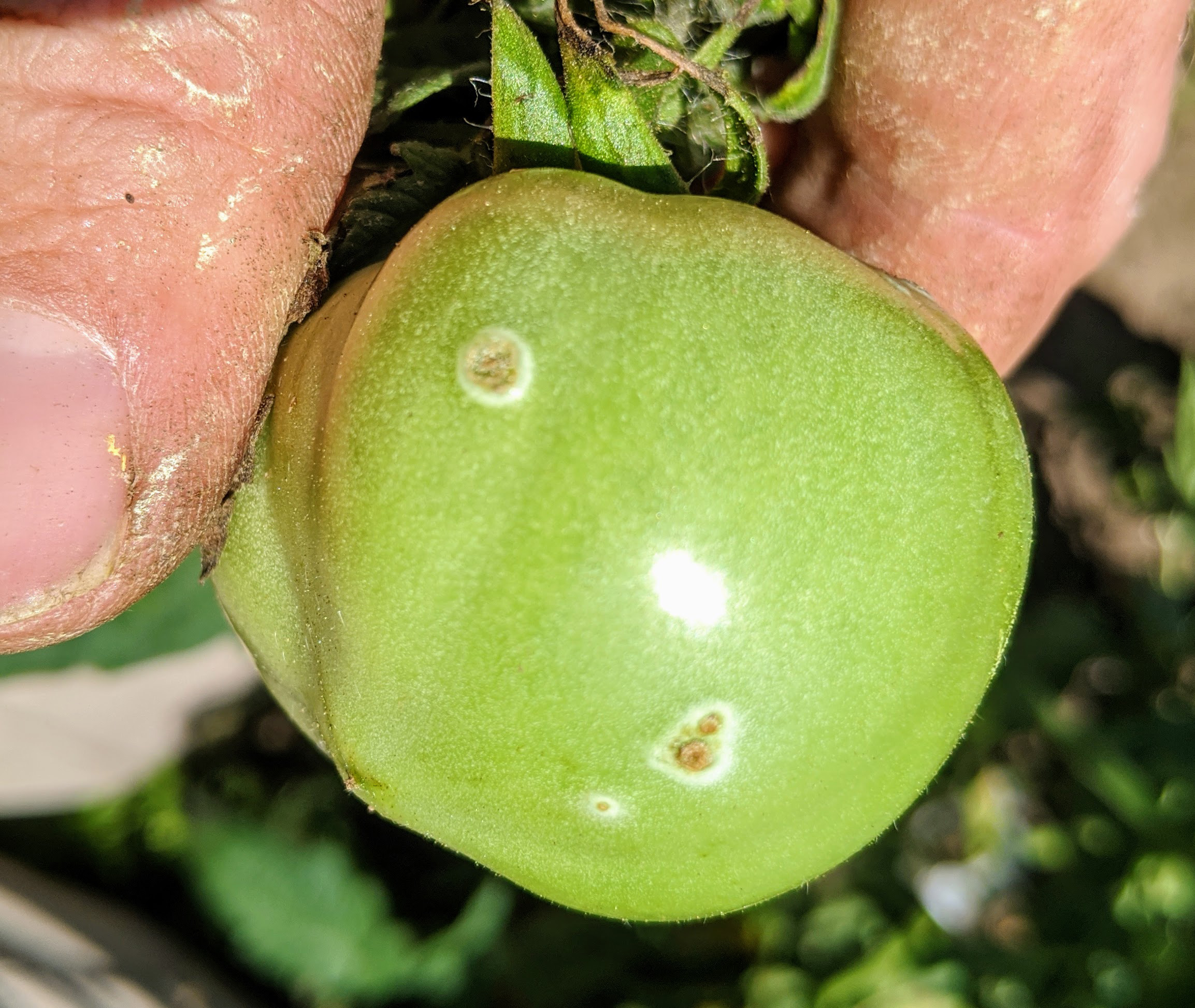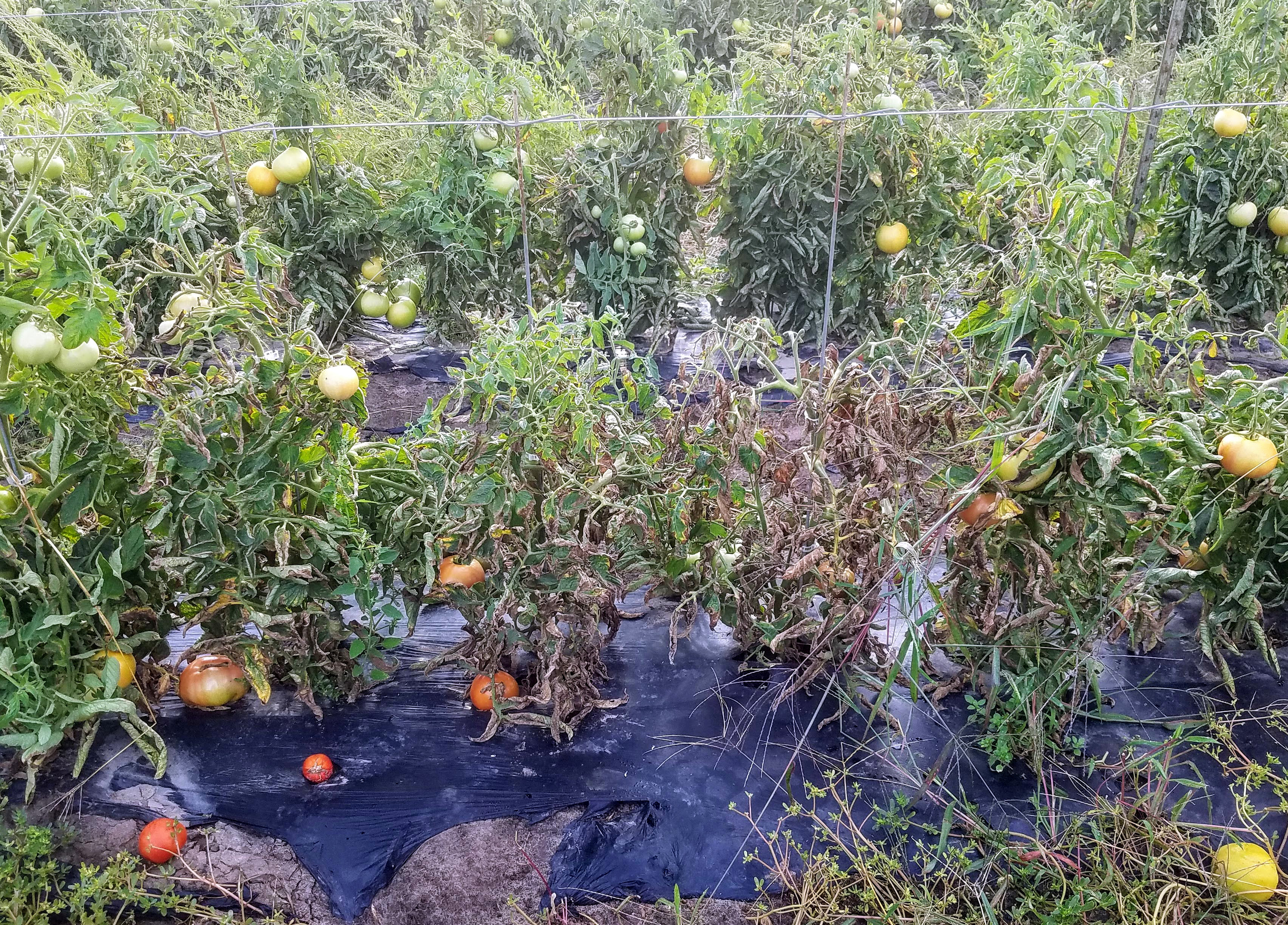West central Michigan vegetable update – Aug. 19, 2020
The finish line is approaching, but keep an eye out for pests and diseases.

Weather
The best chances for rain in northern Michigan will be overnight tonight, Aug. 19, with more chances Friday-Saturday, Aug. 21-22. For the lower two-thirds of the Lower Peninsula, there could be a small chance for rain Sunday into Monday; other days will be dry. After this weekend, the next best chance could be the middle of next week.
Precipitation is forecast to total 0.25 inches or less for the next seven days, with higher amounts predicted in this range to the north and less to the south. Highs will be in the upper 70s today with lows in the 50s, but it will warm up into the 80s with lows in the 60s by this weekend through early next week.
The medium range forecast calls for cooler and wetter than normal weather for Aug. 26 – Sept. 1.
Crop updates
Asparagus rust was producing teleospore lesions at one field I visited this week (Photo 1). These black lesions signal that the rust fungus is getting ready for winter. If you are mainly seeing black lesions, this is also a good signal that tebuconazole is likely no longer critical to apply (the fungus is focusing on overwintering, not causing mayhem in asparagus). The repeating stage of rust-which causes epidemics and plant death-is orange.
Marestail has been an issue this year in some locations. In spring, rosettes are fairly easy to burn down with 2,4-D. However, this year in problem spots, there was more germination this spring during harvest. In this situation, Bernie Zandstra, Michigan State University Extension weeds specialist, suggests that Spur (active ingredient clopyralid) can be applied at lay-by to burn down these escapees.
Carrot growers have been focused on fungicide application. You could include the following products in your rotation for prevention of foliar blights (Photo 1):
- Chlorothalonil (FRAC M5)
- Cabrio or Quadris (FRAC 11) plus chlorothalonil (FRAC M5)
- Luna Tranquility (FRAC 7/9) or Merivon (FRAC 7/11)
Celery scouts reported that scattered aphid infestations are the main pest growers are facing right now. Low levels of celery leaftier moths have also been flying. Lannate or the pyrethroids should help with leaftier if it is of concern. Thankfully, during cool weather, caterpillars are less likely to move down into the heart. As onions go down, consider that Radiant (one-day preharvest interval), Lannate (seven-day preharvest interval), Minecto Pro (seven-day preharvest interval) and Exirel (one-day preharvest interval) all have activity against onion thrips in addition to caterpillar pests.
Cole crop growers should keep an eye out for caterpillar pests. Cabbage looper has been present in addition to diamondback moth. Organic growers with cabbage looper should consider switching from Bt to spinosad, which is more effective against this pest. Conventional growers can turn to standard chemistries for control, including pyrethroids or chlorantraniliprole (in Coragen and Beseige).
Cucurbit downy mildew has now been confirmed in 14 counties. MSU plant pathologist Mary Hausbeck recommends that all cucumber, pickle and melon growers be on a rotation of Orondis Opti, Ranman and Zampro on a seven-day schedule where protection is desired. Chlorothalonil should be tank-mixed with both Ranman and Zampro; it is pre-mixed with Orondis Opti.
As of late last week, only clade 2 had been detected. This clade of downy mildew infects melons and cucumbers, but not squash. Clade 1, which infects squash, had not been detected. Note there are look-alikes out there (Photo 2), so please get foliage tested if you suspect downy mildew in squash or pumpkins! Your one-stop shop for all things downy mildew is here.

I know this is a repeat, but I wanted to mention again that Phytophthora capsici may be causing issues in some locations. For zucchini, products with a zero-day preharvest interval that could be rotated on a seven-day schedule to protect fruit include:
- Orondis Opti
- Revus
- Zampro
For winter squash, remember that protection of acorn, butternut, spaghetti and Buckskin fruit is most critical for the first 21 days after fruit set. After this, fruit develop a degree of age-related resistance. Products include:
- Best products: Ridomil Gold Bravo (where resistance is not present) or Orondis Opti.
- Revus is another good product that has performed well in winter squash trials and could be a rotational partner with Ridomil Gold Bravo or Orondis Opti.
- Presidio could also be considered as a rotational partner.
Onions of earlier varieties have been laying down as we make the swing from in-season management to harvest.
For peppers, potatoes and tomatoes, late blight was detected in Wisconsin last week. Overall, it’s thankfully been a light year for late blight. Chlorothalonil can continue to provide good protection for tomato and potato growers if used on a regular schedule. Bacterial canker continues to cause issues on some farms across the state. It can be a confusing disease to diagnose, as infected plants may or may not have the easy-to-recognize fruit symptom (Photos 3 and 4).


Sweet corn growers should continue to protect silking corn against corn earworm. Across the state, conversations I’ve had suggest trap catches overall have still been pretty low, warranting protection but not super tight spray intervals. I did see an uptick in captures in an Oceana County trap this week, where I captured three moths per night. Trap catches were lower at an Ottawa County location. At trap captures below five per night in a wire trap, a five -day spray interval can be considered.
Western bean cutworm moth numbers declined for the second week in a row at an Ottawa and Oceana County location, suggesting the main flight of this pest might be coming to an end. However, some damage was observed in tassels in southeast Michigan, but as long as you initiate your earworm sprays promptly you should be OK.
One scout noted the presence of fall armyworm in field corn; remember this migratory pest can cause issues apart from earworm.
Corn leaf aphids have been present in tassels on row ends at one location I visited (Photo 5), but a scout I spoke with has not seen any widespread issues. It could be worth keeping an eye out for aphids. It is mainly an issue when aphids colonize the ear where they can be a contaminant. Brigade (active ingredient bifenthrin, one-day preharvest interval) and Lannate (active ingredient methomyl, zero-day preharvest interval) both carry aphids on their label and also have activity against caterpillars.

Tar spot has been detected in Muskegon, Kent, Allegan, Van Buren and Cass counties this year, but I have not heard of any reports of it causing issues in sweet corn.



 Print
Print Email
Email

